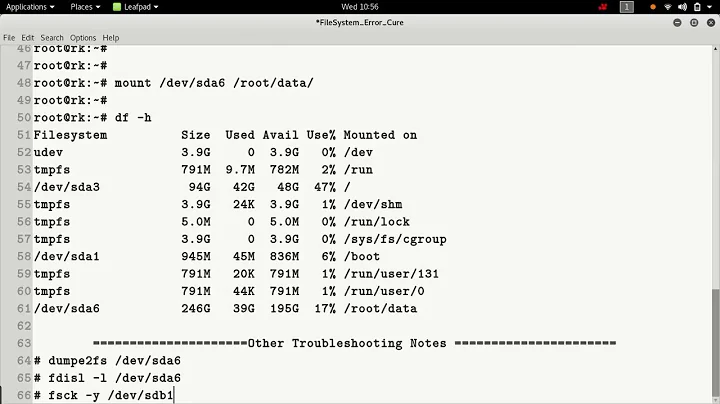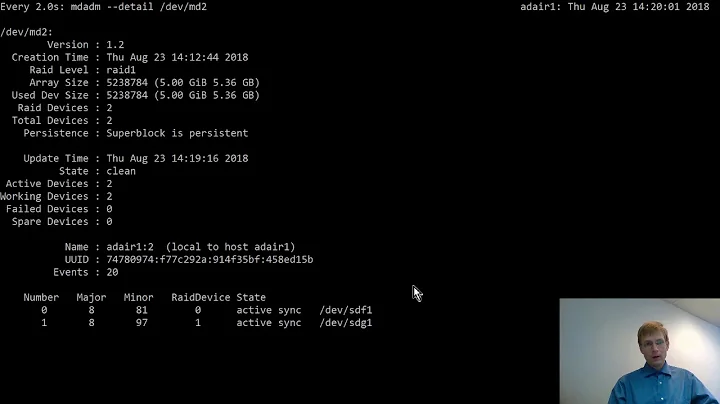Why does mdadm --zero-superblock preserve file system information?
Because zero-ing the mdadm superblock only removes the metadata that describes the raid array, it doesn’t remove information about what is actually on the rest of the disk. This is actually a good thing, as it means you might be able to recover a volume when the array itself won’t assemble for some unfortunate reason.
And to be clear: because you’re creating the array using volumes and not whole-disk, the partition table isn’t touched by mdadm, so zero-ing the raid superblock isn’t going to affect the drive label nor the partition structure.
Related videos on Youtube
nh2
I run my own software consultancy company. Usually I build high-quality systems in Haskell (which I have used at Google, Tsuru Capital and FP Complete), but have in-depth experience with lots of other technologies as well. I like to make, and use, stuff that works well. If you need professional help, contact me at [email protected].
Updated on September 18, 2022Comments
-
nh2 almost 2 years
I have two hard drive partitions, which I have combined into a RAID1 using
mdadm, and created an ext4 filesystem on the resulting device.When I
mdadm --zero-superblockthe two partitions, and re-create the RAID, then the original ext4 metadata is magically preserved.Why is that?
And how can I tell
mdadmto give me a truly new, uninitialised MD?
Details
How I create the RAID1 and file system:
ls /dev/sdc2 # partition 1 ls /dev/sdd2 # partition 2 mdadm --create --run --verbose /dev/md1 --level=1 --raid-devices=2 /dev/sdc2 /dev/sdd2 mkfs.ext4 -L mylabel /dev/md1Wipe RAID1:
mdadm --stop /dev/md1 mdadm --zero-superblock /dev/sdc2 mdadm --zero-superblock /dev/sdd2Recreate RAID1:
mdadm --create --run --verbose /dev/md1 --level=1 --raid-devices=2 /dev/sdc2 /dev/sdd2Display device information (note
wipefswithout the-aflag doesn't wipe anything but just shows info):# wipefs /dev/md1 offset type ---------------------------------------------------------------- 0x438 ext4 [filesystem] LABEL: mylabel UUID: 3d230d31-fb82-46ef-a4e0-e9473e05825cLABEL: mylabelshows that the ext4 label "survived" the mdadm superblock wipe and RAID recreation.How can that be?
I thought that after a superblock wipe and recreation, mdadm is supposed to present me with a "clean" view of the device (i.e. all zeros), unless a flag is given that turns that off (such as
--assume-clean, which I haven't given). -
RibaldEddie about 6 years@Slartibartfast yeah missed that part.
-
nh2 about 6 yearsA few questions: 1) If zeroing the superblock does not have any effect on what reads return from the RAID, then data from which of the two devices will reads return? And given that mdadm immediately starts filling the drive with zeros after creation in the initial scrub, does it mean that within the first couple of minutes, I can read arbitrary data from (one of) the disks, and a few minutes later I will read zeros? 2) I'm not sure about what you say in the "to be clear" part. The ext4
LABEL: mylabelshould surely reside within the boundaries of the raid device, right? continuing ... -
nh2 about 6 yearsSo I'd expect
LABEL: mylabelto be probably somewhere at the beginning of/dev/md1. That's why I'm not sure why you mention "the drive label" or "the partition structure". And of course 3) how can I tell mdadm to return "fresh" data (zeros)?dding the whole 10TB drive takes awefully long and mdadm must certainly know which areas are untouched since the creation (as it knows what to scrub in the initial scrub). -
RibaldEddie about 6 years@nh2 I think there’s some misunderstanding. Zeroing the superblock isn’t having an effect on reads of the volume or partition table because you’re not altering that data when you create or destroy the raid device.
-
RibaldEddie about 6 yearsHere’s another way to think about it: Linux kernel takes a very layered approach to disk management. That’s why there are multiple and separate kernel areas for raid, logical volume management, block device. When you try to read a partition table on a device, if it’s there, the kernel can make sense of that regardless of the presence of any mdraid metadata because the subsystem that reads the partition table doesn’t know or care about mdraid metadata. Does that make more sense to you?
-
nh2 over 5 years@RibaldEddie There's still something I don't understand, which is how mdraid decides where to read the data from. Assume that after I stop the array and wipe the superblocks, I write garbage data to one of the two devices (say
sdc2). Then after I recreate the array, what will happen? Will reads frommd1return garbage, or good data, or nondeterministic results? Naturally, whatwipefsthinks about the ext4 filesystem onmd1must also depend on that answer. -
 Ashark over 3 yearsThe answer is not very clear. The author wanted to wipe raid signatures (including raid label). But after doing that, it is still there. Why that is happening?
Ashark over 3 yearsThe answer is not very clear. The author wanted to wipe raid signatures (including raid label). But after doing that, it is still there. Why that is happening?




